This post and the photos within it may contain affiliate links. If you purchase something through the link, I may receive a commission at no extra charge to you.
What is the best calligraphy pen for beginners? That’s probably one of the most common questions I constantly get.
Instead of listing a bunch of popular calligraphy pens, I decided to create a comprehensive guide that will help you choose the right calligraphy pen for you.
Before we get started, here is a quick overview of the things I’ll talk about in this article –
- Understanding why the best calligraphy pen may vary (calligraphy pen categories)
- The best calligraphy pens for beginners
- What other calligraphy tools do you need to get started
- A quick sum-up + final words
Without any further delays, let’s get started!
If you prefer to watch, I also created a YouTube video –
If you’re a complete beginner, check out the calligraphy beginner’s guide first.
Understanding why the best calligraphy pen may vary (calligraphy pen categories)
Imagine someone asking you – What is the best instrument for music?
You would probably wonder what type of music we are talking about exactly?
That is precisely why “it depends” is the only answer I can give when someone asks me what is the best pen for calligraphy beginners.
Think of calligraphy as an umbrella term with a whole bunch of different scripts (styles) sitting underneath it.

The most common way beginners do this is to first pick up a cool/fancy-looking pen, then figure out what they want to learn.
Well, what if the pen you picked isn’t suitable for the style you want to learn and practice?
It is precisely the reason that my recommendation is to reverse the process.
First, you determine what sort of calligraphy script (style) you are interested in learning, and then based on your choice, you choose your calligraphy pen.
Even though there are hundreds of different calligraphy scripts that you could learn, most of them can be created using the same tools.
In fact, there are three main calligraphy pen categories to consider (unless you’re trying to learn some weird unknown style that requires some weird and unknown tool) –
- Broad-edged calligraphy pens
- Pointed nib calligraphy pens
- Brush pens

Let’s have a closer look at each of these categories.
The best calligraphy pens for beginners
In this section, I’ll briefly go over these pen categories, and I’ll give you my best recommendation for beginners, along with a few alternatives.
Obviously, there are many more calligraphy tools available out there, here im merely making a recommendation for beginners.
If you want a more in-depth look at the different calligraphy scripts (styles), I recommend checking out my other article on the calligraphy alphabets and their historical overview.
Alternatively, I recommend getting the Calligrapher’s Bible book by David Harris.
However, you can also check out these other calligraphy books.

This book features 100 different calligraphy scripts (styles) and a brief sum-up on how to do them.
Let’s begin with our first calligraphy pen category.
Important note: I made a mistake when I started thinking that more expensive tools would help me write better. That’s simply not the case, and you don’t need to spend a lot of money on tools to get started.
Best broad-edged calligraphy pens
This is the largest calligraphy pen category.
Meaning that by getting one broad-edged pen (flat tip), you’ll be able to learn a whole bunch of different calligraphy styles.
The most popular styles created using a broad-edged calligraphy pen are –
Blackletter/gothic calligraphy
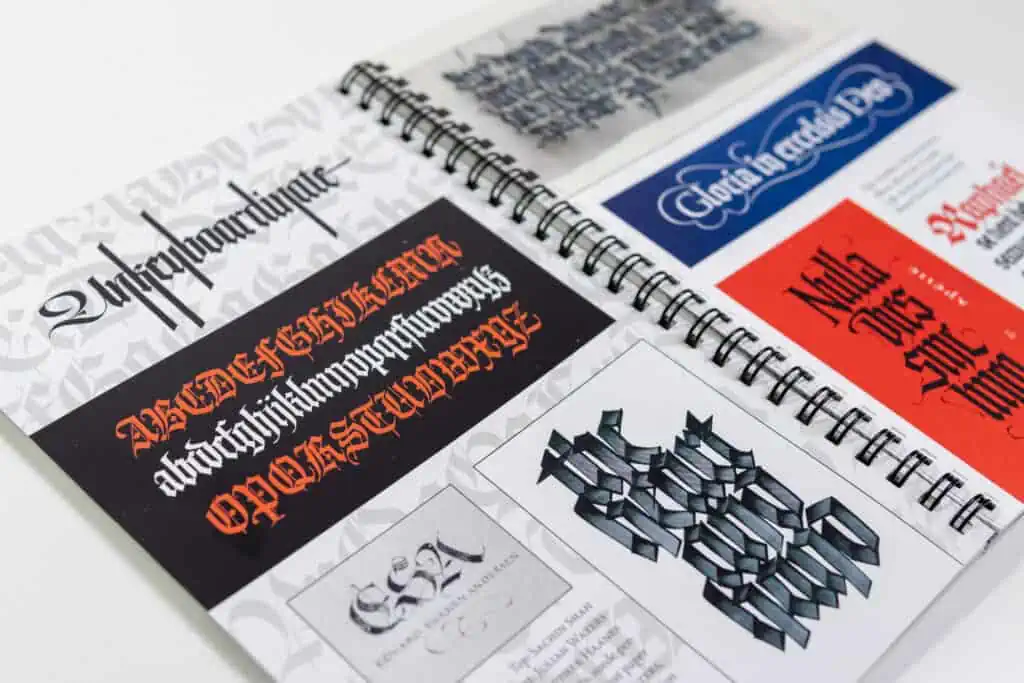
Italic calligraphy
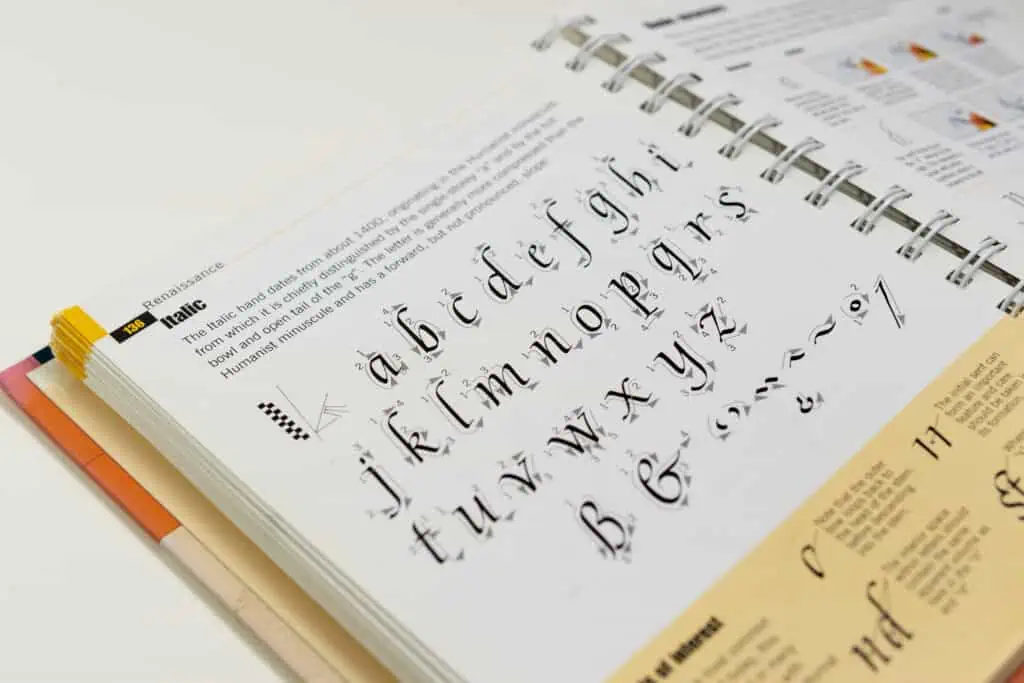
Foundational Hand
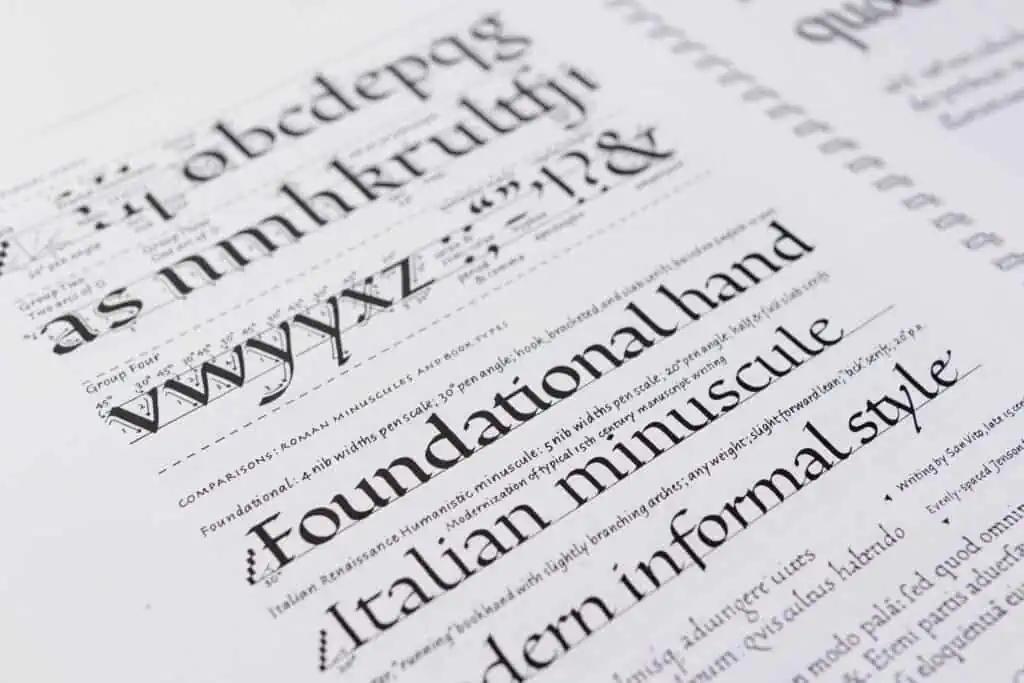
Roman capitals
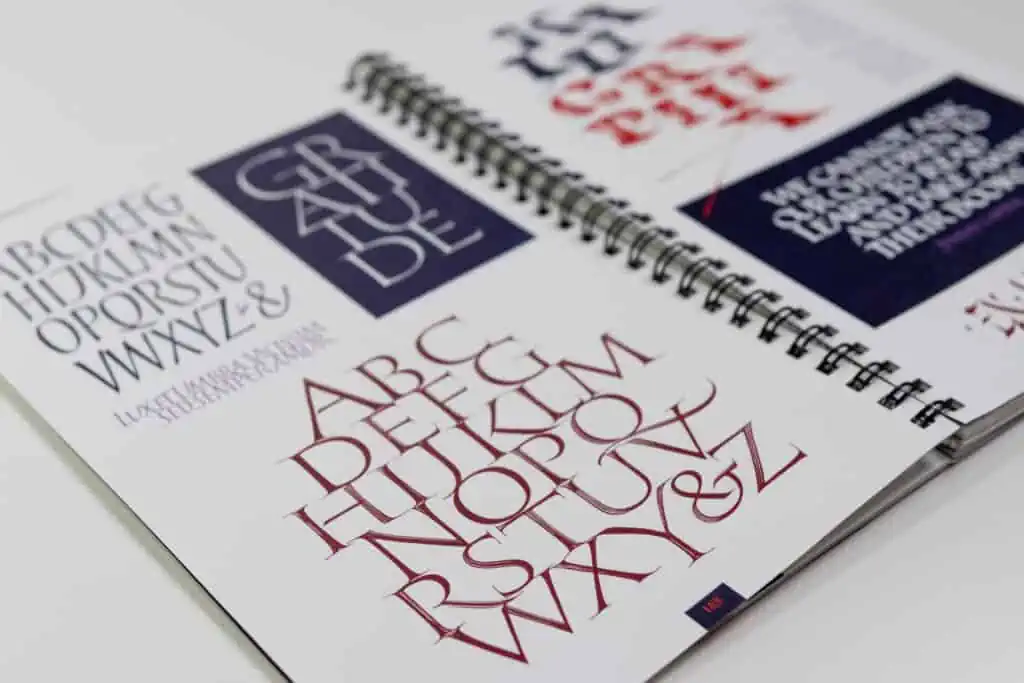
Uncial calligraphy
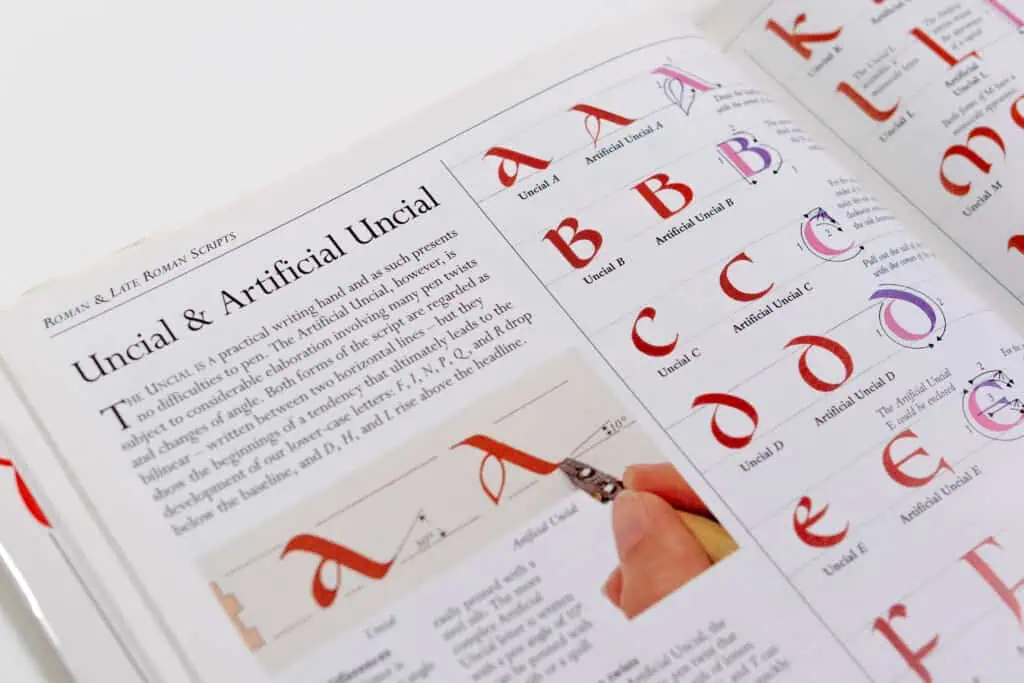
My recommendation for beginners is the Pilot Parallel Pen.

The Parallel Pen is probably one of the most popular tools amongst calligraphers, and for a good reason.
It’s cheap, durable, and easy to use.
The Parallel Pen is a fountain pen that uses ink cartridges in its reservoir. It provides a constant ink flow through the flat nib.

This means that you don’t have to worry about dipping your pen into ink or anything similar. Instead, you just pop it open, and you’re ready to roll.
The PPP comes in 6 sizes –
- 1.5 mm
- 2.4 mm
- 3.0 mm
- 3.8 mm
- 4.5 mm
- 6.0 mm

My recommendation is that you don’t get anything under 3.8 mm.
A larger-sized nib is more suitable for beginners, and you can easily expand your toolbox later on.
The ink box included comes in 12 different colors giving you a wide range of choices.
On top of that, you can combine these colors to make some cool gradients and even dip them in different kinds of ink to achieve other intricate combos.

I couldn’t recommend enough the Parallel Pen.
I use it constantly, and I’ve been using the same one for more than 5 years.
Perhaps the only downside to the PPP is the ink flow. Working with certain papers, the PPP is prone to bleeding and feathering. However, using the right paper, you don’t have to worry about that.
The papers I recommend using with the PPP are –
- Canson marker paper (or any other marker paper)
- Watercolor paper
- Rhodia pads
Broad-edged calligraphy pen alternatives
Aside from the PPP, here are a few pen alternatives you can get for broad-edged calligraphy styles.
Broad-edged markers
These are solid felt-tip markers that are even easier to use than the Parallel Pen.
You just pop the cap, and you’re ready to go.
No preparations, no maintaining, and they can work with a broader range of paper types.
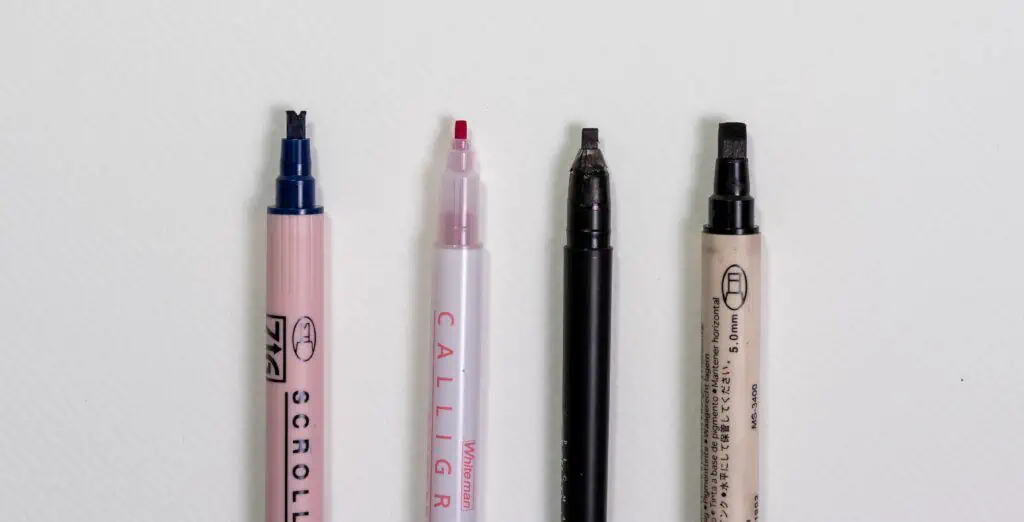
I placed them as an alternative to the Parallel Pen because, in my opinion, they don’t provide such a satisfying writing experience.
However, they’re great for beginners, and you can just focus on learning the basics of a calligraphy style.
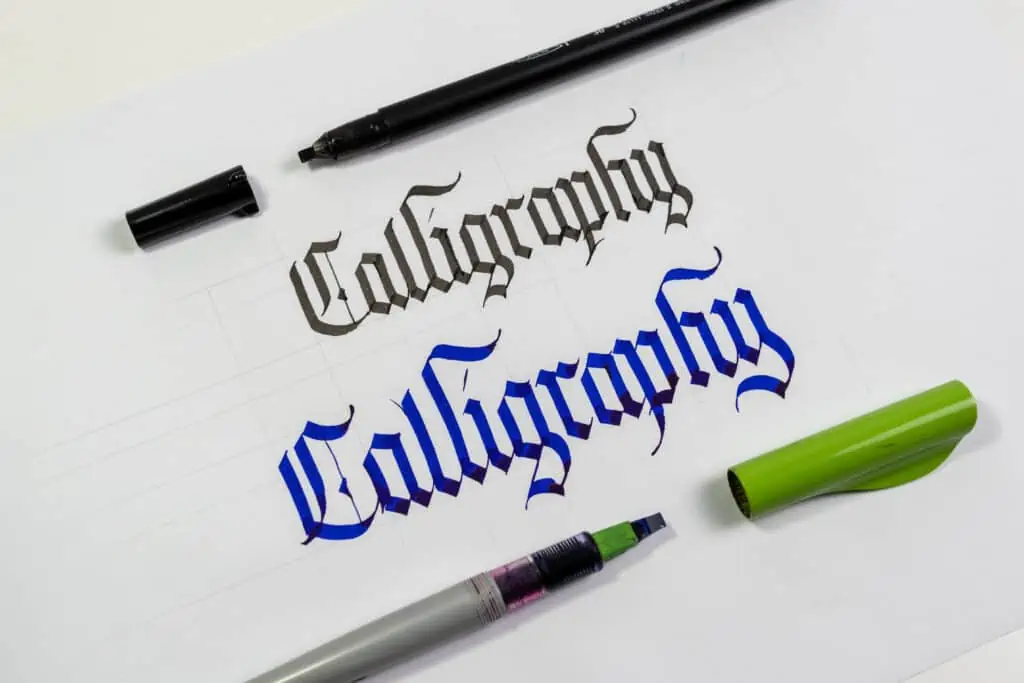
I still use broad-edged markers, and I enjoy working with them.
The ones I recommend are –
- Kuretake Zig Calligraphy
- Kuretake Zig Calligraphy 2
- Sakura Pigma Calligrapher
- Speedball Elegant writer
Whichever you end up taking, I would just recommend that you avoid getting chiseled tip markers like this one –
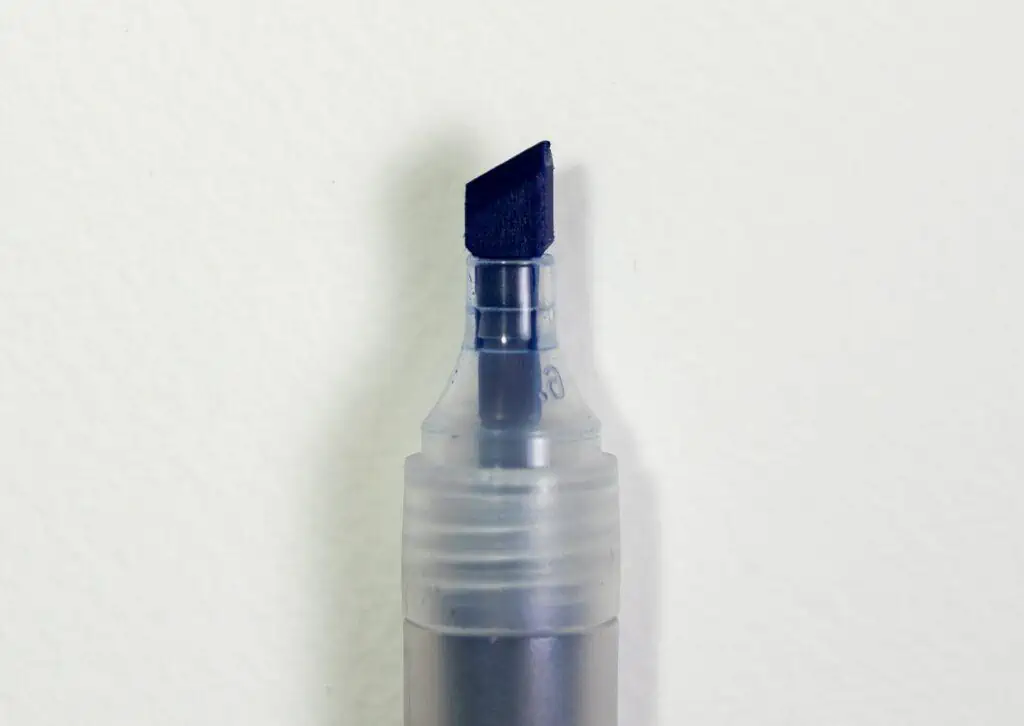
They are not suitable for calligraphy.
Broad-edged dip pens
Broad-edged dip pens are the best tools for professional calligraphy (aside from quills).
They’re able to create strokes and hairlines like no other tool.

In my opinion, dip pens are not really suitable for beginners for several reasons.
First, you need to prepare the nibs (link), assemble them onto the pen staff, find the right paper & ink combination, clean and maintain these nibs and more.
Combine all the other information you need to learn about other tools, scripts, etc. It can quickly become overwhelming.
Don’t get me wrong, it’s not rocket science, but it definitely has a bit of a learning curve.
Nonetheless, I realize that some of you might want to try them out, so that’s why I included them as an alternative.
The beginner’s sets I recommend you start with are –
- Speedball C Style Lettering Set – Includes a (straight) nib holder and 6 C-style nibs in different sizes.
Or
- Manuscript Calligraphy Round Hand Box Set – Includes a wooden (straight) nib holder, 10 nibs in different sizes, and a small ink reservoir.
Along with the set, you will also need some ink.
For that, I recommend a bottle of black Sumi ink. It offers excellent value for the price.
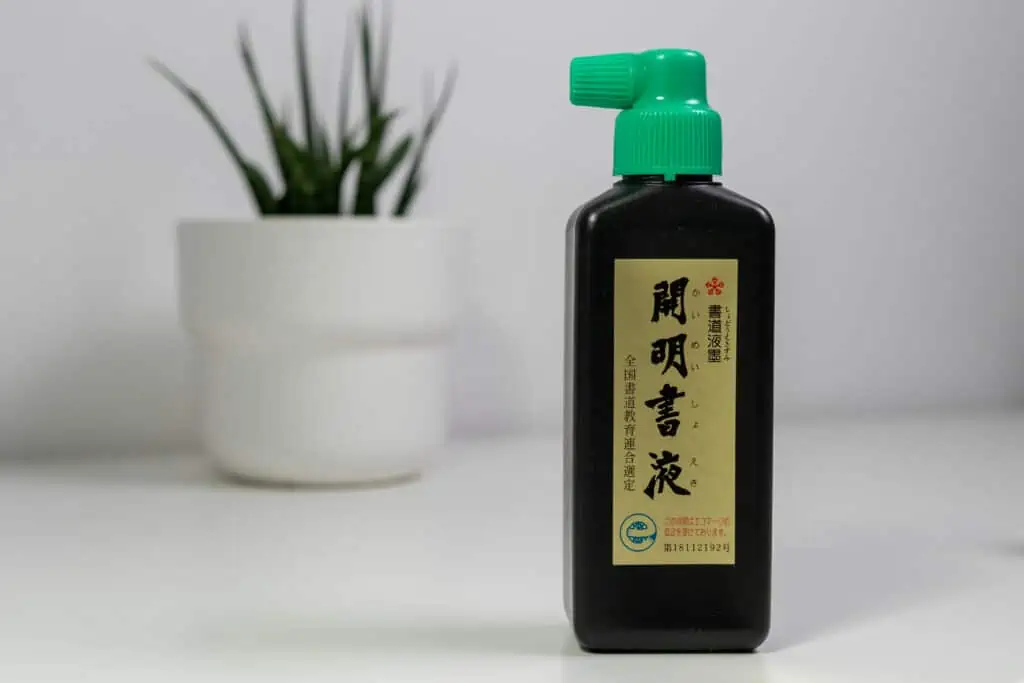
There is also a wide variety of different nibs that you can get.
Once you have a nib holder, you simply swap the nibs.

Paper recommended –
- Canson Watercolor Paper
- Rhodia Paper Pad
- Canson marker pad (or any other marker paper)
Ok, that pretty much covers it for the broad-edged calligraphy styles.
Next up we have –
Best pointed (nib) calligraphy pens
Pointed nib calligraphy styles have become extremely popular, and I would even dare to say it’s the group of styles preferred by the majority of beginners today.
Smooth, flowy, elegant lines are just some of the features that attract newcomers to these calligraphy styles.
Some of the most famous calligraphy styles you can create with pointed nibs are –
Copperplate

Spencerian

Modern variations

Pointed capitals & minuscules
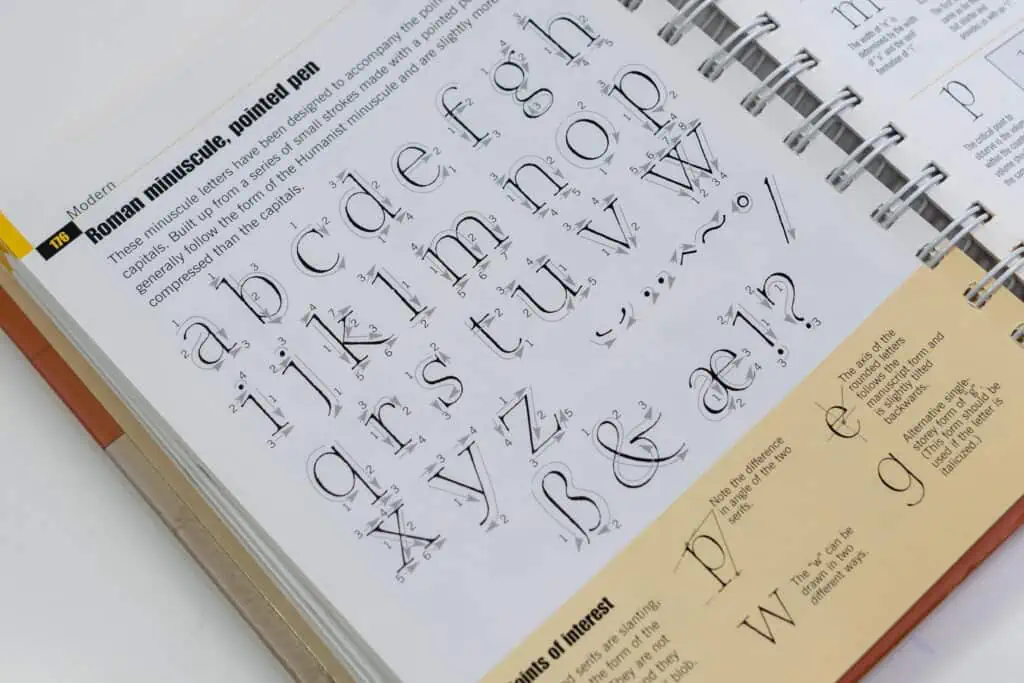
My recommendation for beginners is actually a regular pencil or even a smaller-sized brush pen.
I actually created a whole separate tutorial on how to do calligraphy using just a pencil.
Let me explain.
A dip pen with a pointed nib is the ultimate tool for these styles.
There is no doubt about it.
However, it would be foolish not to take into consideration the learning curve behind this tool.
The argument is the same as the one I made for broad-edged dip pens.
You already have your hands full with learning the basics of the script, and adding to that a tool that comes in multiple pieces that require preparations and maintenance can quickly become overwhelming.
That’s why starting with a pencil, or a small-sized brush pen is a more suitable choice for a beginner.
You’ll have a more pleasant learning experience.

Let me start with the pencil.
The pencil is by far the most underrated calligraphy tool out there.
It’s cheap, it’s durable, and it is incredibly versatile.
Best of all, you probably have a pencil lying around your house somewhere.
A pencil is a suitable tool for beginners because it works on the principle of pressure.
The pencil I recommend getting is one with a softer lead, from a 2B pencil all the way to a 6B.
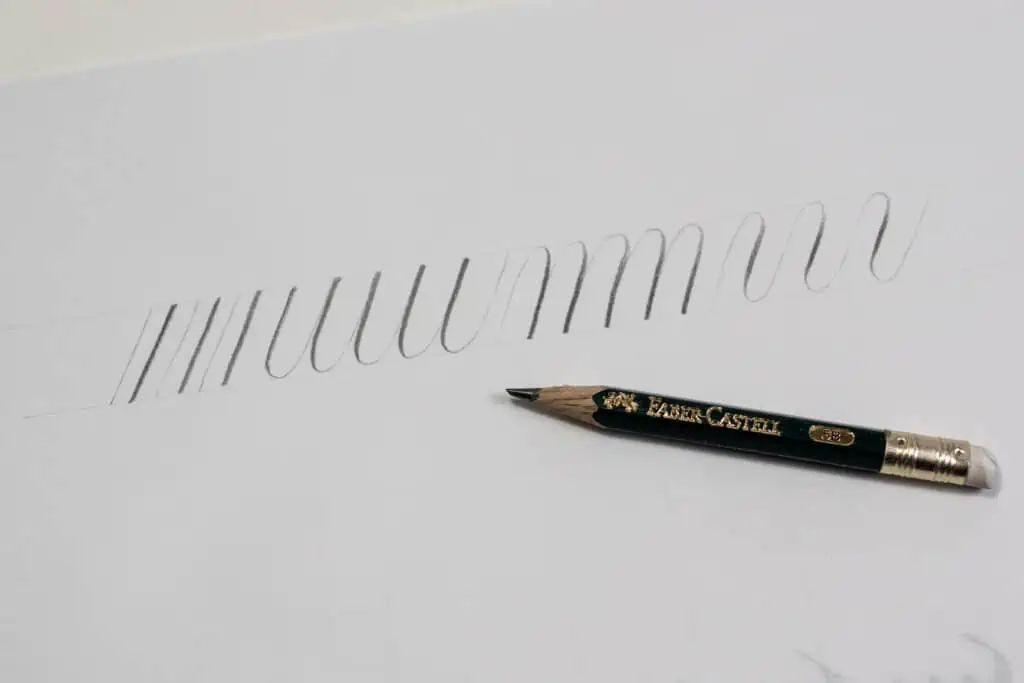
The pencils with a B lead will be soft enough for you to see the difference between the thick and thins without having to add a whole bunch of pressure.
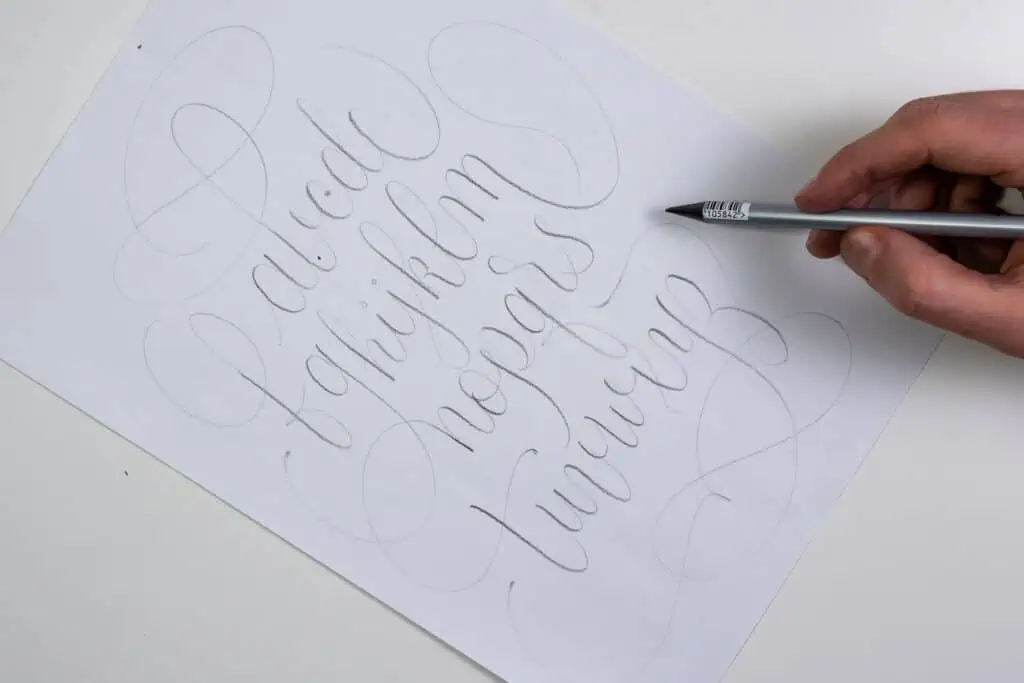
Smaller-sized brush pen
Just like with the pencil, a smaller-sized brush pen is easy to use.
It has a flexible tip that creates thick and thin lines based on the amount of pressure you add as you write.
This allows you to get a similar look that you would achieve with a traditional dip pen and a pointed nib.
The two smaller-sized brush pens I would recommend are –
As for the paper recommendation –
- HP Premium 32
- Rhodia paper pad
- Canson marker pad (or any other marker paper)
- Watercolor paper
Dip pens with pointed nibs
Finally, we get to the real deal.
Again, although I don’t think that a beginner should start with this tool, I understand that some of you would like to do so.

Before I give you my recommendations, I would just like to point out that there are two main types of pen holders –
- The straight holder
- And the oblique holder

The main difference is that the oblique holder has a flange sticking on its side, making it easier to write at certain angles.
So if you are interested in getting started with pointed nib calligraphy, here is my recommendation.

The Moblique Pen Holder by Louis Creations is a fantastic 2 in 1 pen holder.
It’s an oblique holder, but you can easily take off the flange and transform it into a straight holder.

On top of that, you can untwist the body, which will reveal a hidden compartment where you can store your nib – very clever.

It comes in different colors, and it just feels great to write with it.
I love it, and I use it for my broad-edged nibs as well.
The Nikko G nib is one of the most popular nibs.
Easy to work with and with medium flexibility.
This is one of the best nibs to start with.
At least the one I liked to work with the most.

With time, you’ll start to experiment with different ones and notice the differences in the nibs.
As for the Sumi ink, as mentioned earlier, it’s an excellent value for the price.
This holder+nib+ink combination might be slightly more expensive, but I really do think it’s worth it.
Especially considering you won’t need to get two separate nib holders.
In case you want something more affordable that includes the needed parts, Manuscript has you covered.
Straight pen holder with pointed nibs –
- Manuscript Nib Pen Set includes a straight holder, 5 different pointed (flexible) nibs, and a small bottle of black ink.
Oblique pen holder with pointed nibs –
- Manuscript Oblique Calligraphy Set – It includes an oblique holder, 3 different nibs, and a small bottle of black ink
Paper recommendation –
- Rhodia Paper Pad
- Canson Watercolor Paper
- Canson Mix Media
- Canson Marker Pad (or any other marker paper)
Best brush pens for beginners
The last category I wanted to cover in this article is brush pens.
The reason for including brush pens as a separate category here is because brush lettering (aka brush calligraphy) has become extremely popular in recent years.
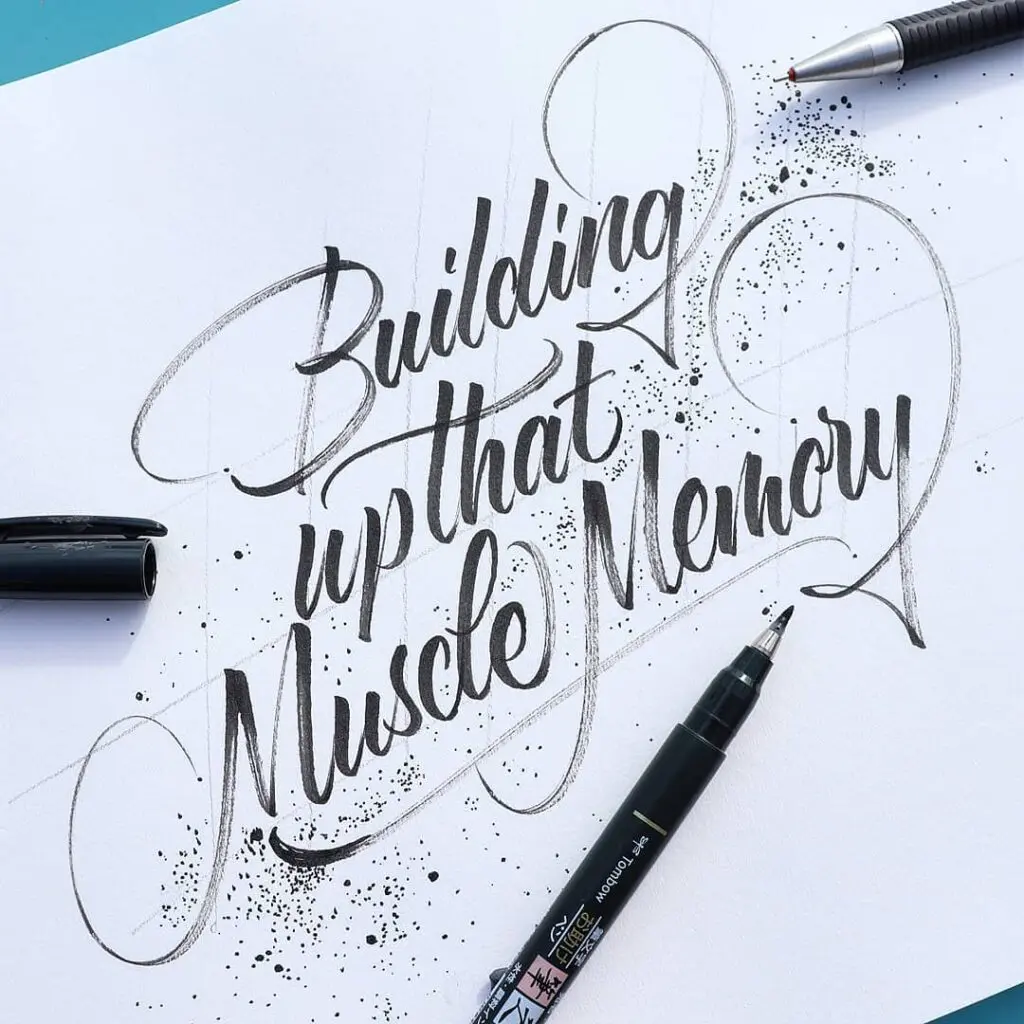
There are many different brush pens available on the market today, and they all differ from each other.
They differ in aspects such as –
- Size
- Nib flexibility
- Ink flow
- Colors, etc.
I created a separate in-depth review of my top 10 picks for the best brush pens for calligraphy.
If you prefer to watch, I also made a YouTube video on the same topic.
You might also be interested in this tutorial where I teach you how to write the whole lowercase calligraphy alphabet using a brush pen.
What other calligraphy tools do you need to get started?
I wrote an in-depth article on the essential calligraphy tools that you can read here.
Nonetheless, here are a few quick recommendations.
Aside from the writing tool that you have chosen based on the calligraphy script (style) you want to practice, you will also need –
- A ruler
- A pencil
- An eraser
- Paper
Here is a quick overview of each one of them.
The ruler
You need a ruler so you can draw calligraphy guidelines. Guidelines are a crucial part of learning and improving your calligraphy.
I wrote a whole separate article that covers everything you need to know about calligraphy guidelines.
Or, if you prefer to watch, I also made a YouTube video –
You can use any ruler you have at hand.
However, the best ruler for creating calligraphy guidelines is the Rolling Ruler.
It’s like a regular ruler, and it just has a rotating cylinder on the backside that allows for rolling on the surface (hence the name).

With the rolling ruler, you’ll be able to quickly and effectively draw straight parallel lines.
I use it constantly, and I highly recommend the rolling ruler to anyone who practices calligraphy or lettering.
The pencil
The pencil is the most fundamental tool for both calligraphy and hand lettering.
It should be a part of any artist’s toolbox.
We use the pencil mostly to draw calligraphy guidelines, but it can be super helpful for sketching or even practicing calligraphy, as I previously mentioned.
There are different types of pencils you can get, and they mainly differ from the mark they leave on the paper.
When it comes to calligraphy, I mostly recommend getting a pencil that leaves a light mark that can be easily erased – an HB pencil.
The one I like to use is this mechanical pencil –

The eraser
I mean, we all make mistakes.
Like with the other tools, you’ll find a variety of different types of erasers out there.
You can pick and use whichever eraser you have at hand.
The paper
This will depend on the calligraphy tool you have chosen to practice with.
Not every paper will work well with every tool.
If you scroll above, you will see that I made a paper recommendation for every writing tool.
I also wrote an article on the best calligraphy papers.
Quick Sum-Up + Final Words
Ok, so let’s have a quick recap of the whole story –
- The best calligraphy pen depends on the style you want to practice. First, pick the style and then the calligraphy pen suited for that script (style).
- Think of calligraphy pens in three main categories – broad-edge, pointed pen, and brush pens.
- You don’t need expensive calligraphy tools – they won’t help you improve your skills.
- I recommend sticking to the fundamental tools and, with time, expand your toolbox.
- Consider the learning curve of a tool if you are just getting started.
- Some calligraphy tools need specific types of paper.
- To get started, you will also need – a ruler, a pencil, and an eraser.
If you want to get a calligraphy tool but are unsure if it’s the right thing you need, feel free to reach out via email or social media. I will be happy to help and share my thoughts.
Once you’ve picked your style and the needed supplies, it’s time to do some practice.
I wrote an article in which I outlined my best tips for practicing calligraphy effectively.
I’m curious to hear what your favorite calligraphy pen is. Do you like more broad-edged pens or pointed ones? Is it maybe brush pens?
Let me know by dropping a quick comment below. 👇👇
Until the next one,
Stay AWESOME!
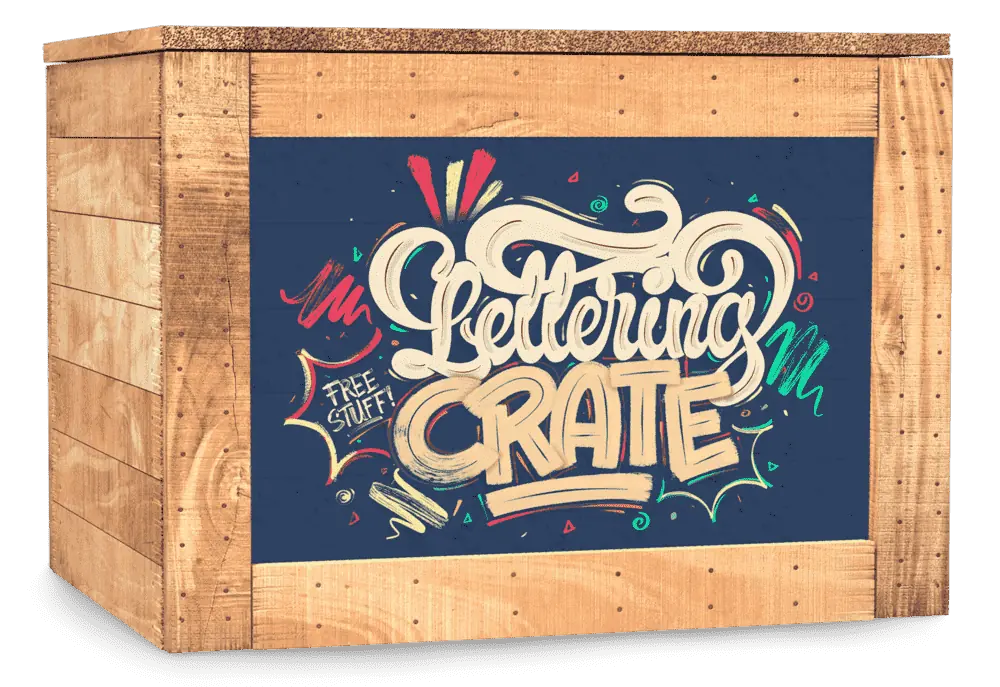
Stay updated with my tutorials and get instant access to the Lettering Crate –
A growing library of free lettering & calligraphy resources that includes –
Pin me!
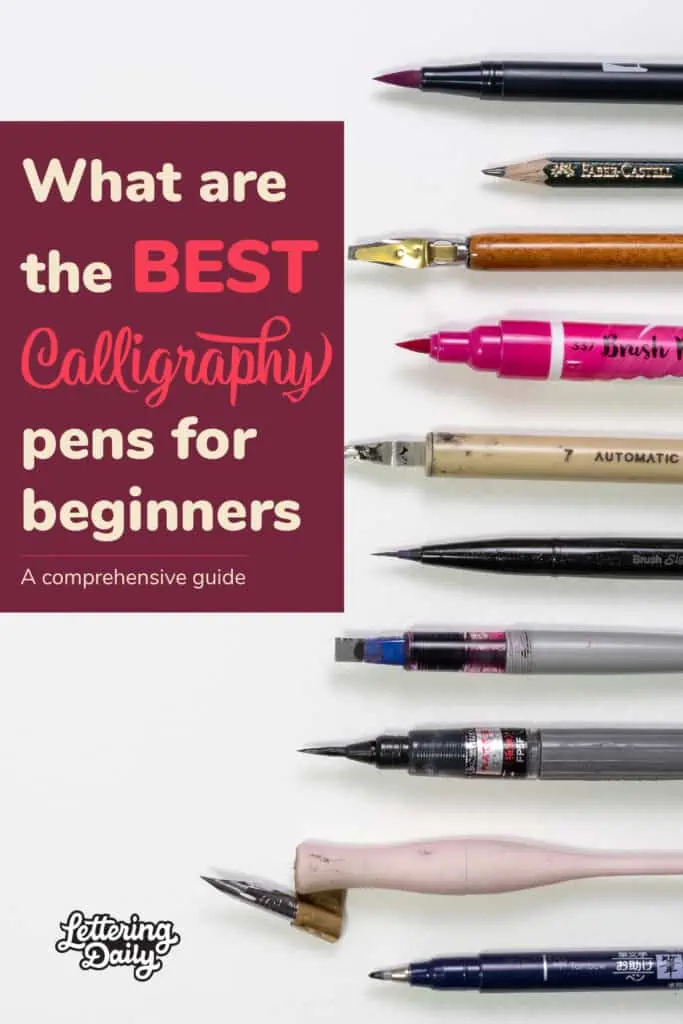
About the author

Hey, I’m Max Juric, and I’m deeply passionate about calligraphy and hand lettering.
I’ve spent years honing my skills in the art of lettering, working with hundreds of clients from all over the world on design projects such as logotypes, branding, custom lettering, murals, and more.
But my journey doesn’t end there. I’ve also dedicated myself to sharing my knowledge and expertise with others, creating a wealth of resources including tutorials, articles, and podcasts.
It’s been incredibly rewarding to see thousands of people engaging with my content each month. Knowing that I’m helping fellow enthusiasts grow and develop their skills makes me really happy.
Welcome to Lettering Daily, your hub for all things lettering and calligraphy. Whether you’re a seasoned pro or just starting out, I’m here to inspire and guide you on your lettering journey. Stick around, and let’s explore the world of letters together!

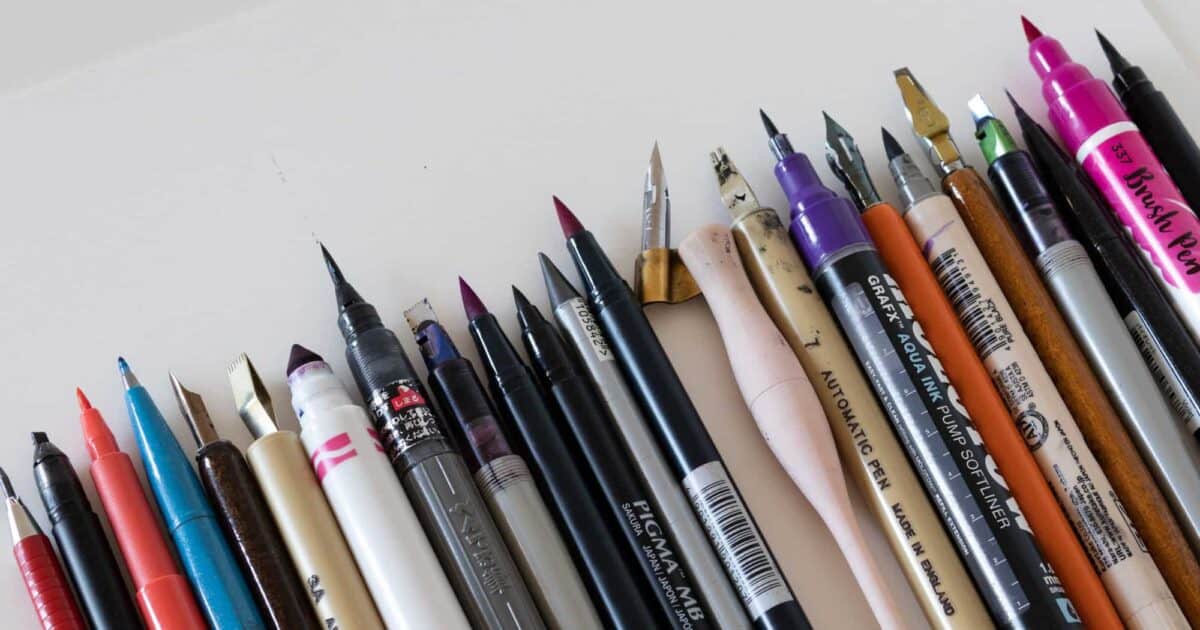
Do you have a recommendation for pointed-nib fountain pens? I’m interested in getting into Copperplate etc but I’d really rather something with cartridges so it’s more easily portable. Any suggestions?
I grabbed the first one I saw at my local craft store – a Speedball Calligraphy Fountain Pen – and have found it terribly scratchy and inconsistent with regards to ink flow, though I’m not sure how much is the pen vs the paper vs my lack of experience
As for now nothing. Im trying to get my hands on one specific pointed nib fountain pen. As soon as i try it out i’ll let you know if it’s worth it or not 😀
I’ve read a lot of articles on calligraphy for beginners and this was by far the most useful.
Thank you, Kayla. It really means a lot to me 🙂
Hello Max
I realise this is an older post, so you may not get around to replying for a while.
My husband, G-d bless him, recently made an impulse purchase of Staedtler calligraphy 3005 double-ended calligraphy pens.
Are these okay for a beginner? I’ve also got a few pencils with different HB leads, as per your suggestion 🙂
I always reply 😀 It just sometimes takes me longer on these comments but you’re always welcome to send me an email – to which i always reply quite quickly. These are broad-edged markers which are great for beginners. As long as you use them for broad-edged scripts 😀 And great choice for the pencil as well! 🙂
Thank you … I have an interest and your site just perked it.
Thank you 🙂
Hi Max.., thank u for this.., just subscribed to ur utube channel..,
Thank you so much! 😉
Thanks so much for a most interesting piece.
I’m picking up again after 30 years and realize I still have much to learn!
Thank you so much, Adrienne! Please let me know if you have any questions 🙂
I don’t agree that if you want to do pointed nib calligraphy then you should start with a pencil. Not unless pencil calligraphy is also something you want to do long term, as a stepping stone it doesn’t make much sense to me, the skills with a pencil don’t really transfer onto a pen all that well and learning how to handle a nib pen takes less than 10 minutes, there’s really next to no learning curve there, I’d suggest to just jump in with a real nib if this is what you want to do. Everything else is spot on though, in particular I couldn’t recommend Pilot Parallels enough, they’re great.
Hello Anna, thank you for your comment. Let me elaborate on why I wrote the part about the pencil. As I mentioned in the article, when starting to work with a pointed nib, there are several steps you need to partake in before you can actually start writing. First finding the right combination of paper and ink, prepping your nib, assembling it to the pen staff, understanding letter proportions, how to size your guidelines (or finding and printing them), etc. That’s all without even mentioning the part about reading upon the basics of a given script that would allow you to get some proper practice done. Sure, if you want to stick a nib on to a holder and do some random type of practice this could actually work. In my experience that approach doesn’t yield any good results. That’s one of the reasons why i see people progressing more in 6 months than others do in several years. As i always say, practice is important but the way you practice makes all the difference. The pencil comes into play for understanding the basics of how a script works, which IMO is far more challenging to grasp than to get the technical elements in place (the ones i just mentioned). Im talking about learning the fundamental thick and thin stroke transitions, the basic calligraphy strokes, letter groups, their proportions, spacing, consistency, etc. The reason this is easier done with a pencil is that it doesn’t require you to completely change the way you hold the writing tool, whereas the pointe nib requires a modification to your hold as well as the motion. Im sorry, i don’t mean to be rude or anything (I actually enjoy getting challenged like this), but to say that you can learn how to handle a pointed nib in less than 10 minutes is pure and utter nonsense. It’s a completely different writing tool than what we are learned to write with in school and in our daily lives. The opinion of starting to work with a pencil for pointed nib calligraphy scripts isn’t just mine. It’s shared with other professionals in the field. At the end of the day, it’s just my opinion. You are welcome to do whatever you want and that’s totally fine. I create this content with MY knowledge and MY experience, and in it I found this to be a better approach. Nonetheless, thank you so much for dropping a comment, I really appreciate it. 🙂
IDK how I never heard you could do calligraphy with just a pencil. I’ve wasted so much time trying to get the hang of metal nibs, giving up in frustration, then having all the ink dried up by the next time I made an attempt. I’m so much happier just practicing the basic strokes and pressure with a plain old pencil!!!!!
Exactly! That’s the whole point of getting started with the pencil. Im glad to hear that you understand my point 😀 My though was – get the basics down using a super easy tool to handle and then move on to the more complicated stuff. Just makes the whole learning process so much easier.
What an incredibly informative post. Thank you so much!
Thank you, Megan. Im glad to hear that you liked my guide 🙂
Thank you for such a relaxed insight into your craft – I have dabbled in this discipline and you have inspired me to resume – and reassured me that while there are so many paths up the mountain, and each will please me in different ways … Sasha
Super happy to hear that 🙂
Your information is very helpful. I want to buy a good beginners calligraphy set for my daughter’s birthday (24 yrs old). Is there a set that you recommend for beginners rather than putting all the separate pieces together and trying to find a container for them all?
Thank you
Hey Stephanie, depends on what sort of calligraphy style you want to learn. The best would be to assemble your own kit as these suppliers still don’t offer a kit that has all the tools needed to get started.
Hi Max,
I am also a fan of PPP. However, I am looking for a pen with a nib thiner than 1.5 mm. Can you advice me please.
Thanks in advance.
You can find nibs smaller than 1.5mm. Try to check speedball, manuscript, brause, etc.
Hello – Did you ever post the Gift Guide? I would be interested in reading that.
Thank you for outlining this in so much detail!
I sure did! You can check it out here – https://www.lettering-daily.com/gift-guide-for-lettering-calligraphy/
Hi Max, great info you are presenting us with, many thanks.
I had already decided that the Pilot Parallel Pen would probably be my favourite pen. The only thing I was worried about was buying cartridges all the time , they don’t last long. As luck would have it i read an article stating that any empty cartridges could be refilled with ordinary ink.
Of course the cartridge has to be cleanly washed out. Refilling is easy using a small blunt needled hypodermic syringe. The best ink to use is Ecoline made by Royal Talens. It only costs about £3.50 for 30ml and, of course you can use for dip pens as well. Ecoline has a large colour range so if anyone is interested in illuminating, the world as it were , is your oyster. I also got lucky and obtained a full set of Automatic Pens at a very good price on EBay. I’ve yet to try them.
Hey Tony, thank you for the kind words. Im glad you liked the article, and the PPP is a great choice!
The inks may seem a bit expensive but if you look around you can find them for much cheaper. If you shoot me an email i could send you a couple of European-based links from where i get my supplies. Nonetheless, the idea of using the Ecoline inks is great. I’ve been working with them for a long time and i love it. You can refil them but make sure to clear your Parallel Pen regularly to avoid getting it clogged. The Automatic pens are fantastic and sounds like you grabbed a good deal! If you have any questions about tools and supplies, feel free to reach out via email at any time 🙂 Cheers!
thanks for the information
https://diy.penkraft.in/
Hi Max, may I ask what the difference is between a chisel tip, a parallel tip and a calligraphy pen like the Staedtler calligraphy duo with 2mm and 3.5mm tips as far as hand lettering is concerned?
Thanks, Rosa
Hey Rosa. Sure! So a chisel tip is a flat nib that has been “cut” at an angle. Chisel tip markers aren’t really the best tools suited for broad edged scripts such as blackletter, italic, capitals, foundational, etc. You can do it with a chisel tip but it requires a higher level of skill.
The Parallel Pen and the Staedtler are both broad-edged pens suited for calligraphy. The difference between them is that the PPP is a fountain pen that uses ink cartridges and the tip is made out of two metal plates. The Staedtler pens have felt tips, they’re more like markers. Both of them are great choices for beginners. I personally prefer more the PPP but I love working with markers as well. I hope this helps you out! Let me know if you have any other questions. 🙂
Hi there,
I loved this blog, full of useful information. Thanks for sharing.
I have to ask though: which book is the one from the paragraph “DIFFERENT CALLIGRAPHY (STYLES) SCRIPTS”? I can only see the summary, but I would love to know the name of the book.
Hey Gisele, the book is called – The Calligraphers Bible. A great book and highly recommended.
Journaling is my thing and I write in two different journals. Do you have more than one journal?
Thank you for all the information. I am look in Gabi to starting from scratch so very helpful info!
You are welcome 🙂
What’s the best pen for spencerian penmanship? After reading your article I was still unsure
Sorry about that Robert! For Spencerian, you will need a pointed pen. An oblique holder and a nib to be more specific. I hope this helps!
Hello! Can you recommend the best calligraphy ink to use as a beginner?
Hey Erika, when we talk about calligraphy ink we also need to talk about the pens/nibs and paper as well. The same ink will behave differently on different kinds of paper or if used with different nibs. These are the calligraphy nuances you will start to notice with time and practice. The more tools you will try and work with, the more you will become aware of the small differences. Considering I am still an amateur as well my knowledge is fairly limited. I’ve tested a lot of different tools and inks as well. A good starting point is – Speedball Indian black ink, Winsor & Newton calligraphy ink, Sumi ink, and perhaps my favorite – gouache. Gouache is great for multiple reasons, but the main two are the color choice and the liberty of adjusting the consistency of the liquid. Let me know if you have any other questions, and i will do my best to help you out 🙂
Hey there! I need a piece of advice I can’t really find anywhere. I would like to offer a calligraphy pen to a friend for Christmas and I found some pretty cool ones but I am wondering what is best between a dip calligraphy pen or a fountain pen. Thanks a lot!
Hey Cris, Sorry for replying so late. I am writing a gift guide as we speak, however, in the meantime I would suggest that you go with a dip pen rather than a fountain pen. Dip pens are in my opinion a more professional tool for calligraphy than fountain pens.
Just one minor note. After I read this article I bought the oblique calligraphy pen only to find out that left-handed people fare MUCH better with the standard calligraphy pen that is not offset since lefties write at a 55-60 degree slant naturally.
Everything else has been very helpful to this left-handed newbie!
Hey Amy, thank you so much for your comment – you are absolutely right! That piece of information totally slipt from my mind, and i’ll be sure to include it in the next update. Cheers! 🙂
Probably the best article I’ve read on Calligraphy with detailed information of everything one would require. Thank you so much.
Thank you Archana! It makes me so happy to hear that 🙂